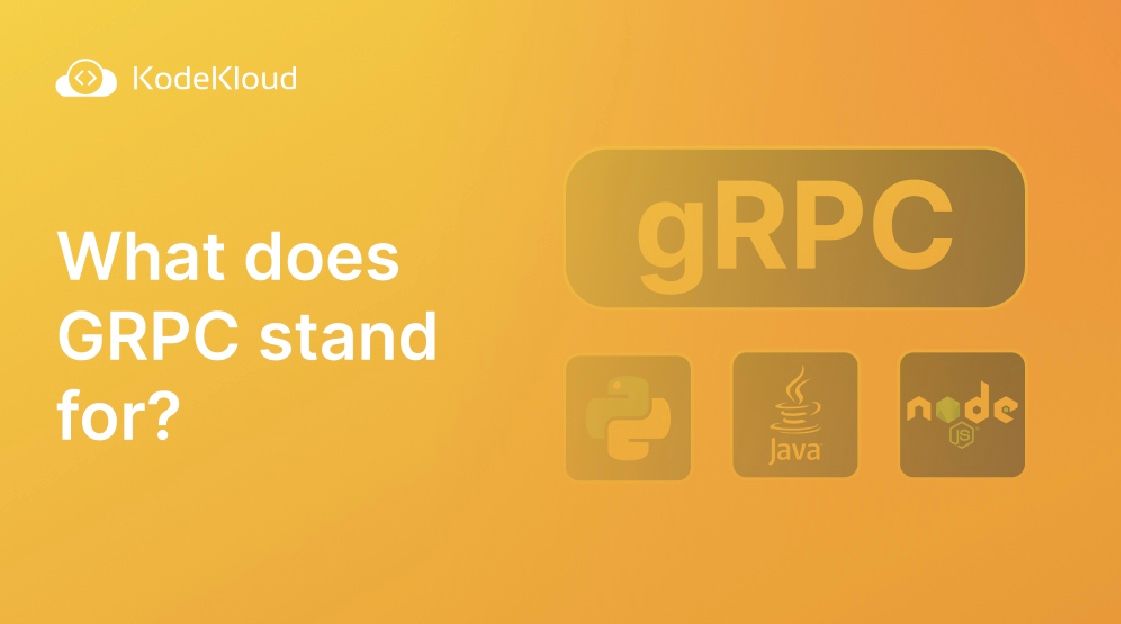If you are a developer who works with distributed systems, you might have heard of gRPC, a framework for remote procedure calls (RPCs). But what role does gRPC play in modern applications setup, and why should you care about it?
In this article, we will explore the meaning, architecture, and benefits of gRPC and how you can use it to build cloud-native applications.
Key Takeaways
- gRPC stands for Remote Procedure Calls, a framework that enables efficient and reliable communication between distributed systems and microservices.
- gRPC can be used in various programming languages and platforms by defining services and messages in proto files, generating code from them, and implementing client and server logic.
- gRPC is a powerful and versatile framework that can help you create cloud-native applications that communicate efficiently and reliably across different environments.
Meaning of gRPC
gRPC is an acronym that stands for Remote Procedure Calls. The lowercase “g” originally meant Google; gRPC was initially created by Google as an internal RPC framework. However, since gRPC became an open-source project in 2015, the “g” is no longer officially tied to Google and can be interpreted as general-purpose or generic.
An RPC is a method of executing code on a remote machine as if it were a local function call. For example, if you have a client application that needs to access some data from a server application, you can use an RPC to invoke a function on the server and get the data back without worrying about the details of network communication, serialization, or protocol compatibility.
gRPC is a framework that implements the RPC paradigm using HTTP/2 as the transport layer and Protocol Buffers as the default serialization format. Protocol Buffers is a binary data format that can efficiently encode structured data into a compact and platform-independent representation. gRPC can also support other data formats, such as JSON and XML, but Protocol Buffers offer the following added advantages:
- Faster serialization and deserialization
- Smaller message size
- Strongly-typed and schema-based contracts
- Language-neutral and cross-platform support
gRPC was first announced in 2015 as part of the Cloud Native Computing Foundation (CNCF), an organization that promotes cloud-native technologies and practices. Since then, gRPC has gained popularity and adoption among developers and companies who want to build high-performance distributed systems and microservices.
Architecture of gRPC
To understand how gRPC works, let’s take a look at the image of the architecture of gRPC.
This shows how gRPC uses HTTP/2 as the transport layer and Protocol Buffers as the serialization format to enable efficient and reliable communication between distributed systems and microservices.
The workflow consists of four main layers: the network layer, the client layer, the server layer, and the protocol buffers layer. The network layer represents the HTTP/2 protocol that gRPC uses to send and receive messages over the internet.
The client layer and the server layer represent the applications that use gRPC to communicate with each other. The protocol buffers layer represents the data format that gRPC uses to encode and decode messages.
The flow involves several steps, such as calling, serializing, sending, receiving, deserializing, handling, and returning gRPC methods and messages using generated stubs and services.
This represents the flow of a typical gRPC call from the client to the server and back. The following steps explain what happens in each stage of the gRPC call flow:
- The client calls a gRPC method using a generated stub that provides the service interface.
- The client serializes the request message using protocol buffers, which reduces the message size and improves the serialization speed.
- The client sends the serialized request message over HTTP/2 to the server, which enables faster data transfer, lower latency, better resource utilization, and bidirectional communication.
- The server receives the serialized request message over HTTP/2 from the client.
- The server deserializes the request message using protocol buffers, which ensures that both clients and servers follow the same contract and avoid errors or inconsistencies.
- The server handles the gRPC method using a generated service that implements the service's business logic.
- The server returns a response message using the generated service.
- The server serializes the response message using protocol buffers, which reduces the message size and improves the serialization speed.
- The server sends the serialized response message over HTTP/2 to the client, which enables faster data transfer, lower latency, better resource utilization, and bidirectional communication.
- The client receives the serialized response message over HTTP/2 from the server.
- The client deserializes the response message using protocol buffers, which ensures that both clients and servers follow the same contract and avoid errors or inconsistencies.
- The client gets the response message using the generated stub.
Benefits of gRPC
gRPC offers many benefits for developers who want to create cloud-native applications that communicate efficiently and reliably across different environments. Some of these benefits are:
- High performance: gRPC uses HTTP/2 as the transport layer, which enables faster data transfer, lower latency, better resource utilization, and bidirectional communication. It also uses Protocol Buffers as the default serialization format, which reduces message size and improves serialization speed.
- Cross-platform compatibility: gRPC supports many programming languages (such as C#, Java, Python, Go, Node.js) and platforms (such as Windows, Linux, macOS, iOS, and Android) with minimal code changes. It also provides code generation tools that can automatically generate client and server stubs from proto files.
- Strongly-typed contracts: gRPC uses Protocol Buffers as the interface definition language (IDL), which allows developers to define the structure and types of the messages and services they want to exchange. This ensures that both clients and servers follow the same contract and avoid errors or inconsistencies.
- Rich features: gRPC supports many features that are essential for building cloud-native applications, such as authentication, encryption, compression, load balancing, health checking, tracing, etc. It also supports different types of RPCs, such as unary (one request, one response), server streaming (one request, multiple responses), client streaming (multiple requests, one response), and bidirectional streaming (multiple requests, multiple responses).
- Streaming: Streaming RPCs allow you to asynchronously send and receive large data sets or real-time updates without blocking or buffering.
- Security: gRPC uses HTTP/2 as its transport layer, which provides end-to-end encryption with TLS/SSL. gRPC also supports pluggable authentication mechanisms that can integrate with your existing identity providers or authorization systems.
How To Use gRPC
To use gRPC in your application, follow these steps:
- Define your service and message types in a proto file using Protocol Buffers syntax.
syntax = "proto3";
// The greeting service definition.
service Greeter {
// Sends a greeting
rpc SayHello (HelloRequest) returns (HelloReply) {}
}
// The request message containing the user's name.
message HelloRequest {
string name = 1;
}
// The response message containing the greeting
message HelloReply {
string message = 1;
}- Generate the client and server code from the proto file using the protoc compiler and the Python plugin. For example, if you have the proto file in your current directory, you can use this command:
python -m grpc_tools.protoc -I. --python_out=. --grpc_python_out=. helloworld.proto
This will generate two files: helloworld_pb2.py, which contains the message types, and helloworld_pb2_grpc.py, which contains the service and client stubs.
- Implement the server logic using the generated service base class:
import grpc
from concurrent import futures
import time
# Import the generated classes
import helloworld_pb2
import helloworld_pb2_grpc
# The server implementation
class Greeter(helloworld_pb2_grpc.GreeterServicer):
# The SayHello RPC method implementation
def SayHello(self, request, context):
# Create a reply message with a greeting
reply = helloworld_pb2.HelloReply()
reply.message = "Hello " + request.name
# Return the reply as a future
return reply
# Create a gRPC server
server = grpc.server(futures.ThreadPoolExecutor(max_workers=10))
# Add the service to the server using the generated class
helloworld_pb2_grpc.add_GreeterServicer_to_server(Greeter(), server)
# Listen on port 50051
print("Starting server. Listening on port 50051.")
server.add_insecure_port("[::]:50051")
server.start()
# Wait for the keyboard interrupt
try:
while True:
time.sleep(86400)
except KeyboardInterrupt:
server.stop(0)- Create and start the client using the generated client stub:
import grpc
# Import the generated classes
import helloworld_pb2
import helloworld_pb2_grpc
# Create a channel to communicate with the server
channel = grpc.insecure_channel("localhost:50051")
# Create a client stub with the channel
stub = helloworld_pb2_grpc.GreeterStub(channel)
# Prepare a request message with a name
request = helloworld_pb2.HelloRequest()
request.name = "World"
# Call the SayHello RPC method and get the response
response = stub.SayHello(request)
# Print the response message
print("Greeting:", response.message)
# Close the channel
channel.close()- Run the server and client applications and see the results. Your result would look like this:
Starting server. Listening on port 50051…
Greeting: Hello WorldYou can get the full code from this page.
To dive deeper into server-client communication protocols, enrol in our Programming Learning Path:

This course has been reviewed and approved by the Python Institute and prepares you for the PCEP certification.
Conclusion
In this article, we have learned that gRPC stands for Remote Procedure Calls, a framework that enables efficient and reliable communication between distributed systems and microservices.
We have also seen its architecture and its benefits. Finally, we have seen how to use gRPC in our applications by defining services and messages in proto files, generating code from them, and implementing client and server logic.
If you want to learn more about gRPC and how to use it in your cloud-native applications, check out gRPC documentation.
More on programming:
- The Easiest Codes to Learn for Beginners
- Learning Python for Beginners
- Should I Learn Python Or Javascript
- Can Python Be Used For Web Development
- How to Start with Python: A Beginner's Guide
- How CI/CD Pipeline Works
- Differences Between Put and Patch in Rest API & When to Use Them
- How to Get Python Certification: The Step-By-Step Guide




















Discussion